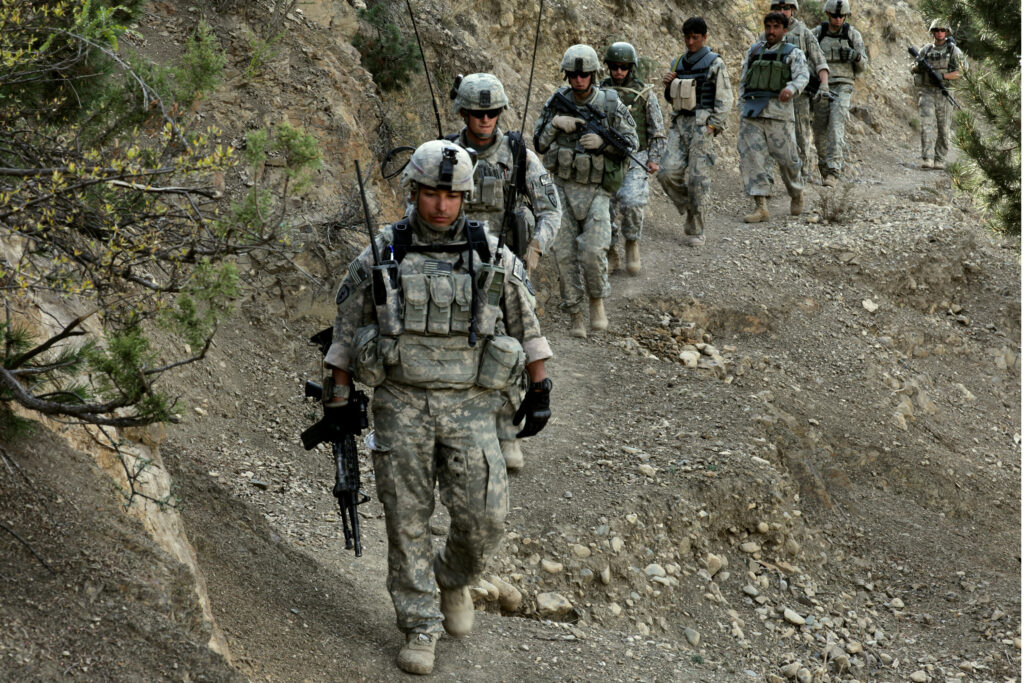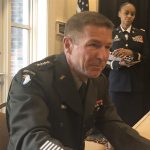
Army soldiers string out on patrol in the mountains of Afghanistan in 2009
WASHINGTON: The Army is deeply unsure how the planned pull-out from Afghanistan — and what comes after — will drive demands on its troops and budget, acting secretary John Whitley said this afternoon. The best case scenario is a smooth withdrawal that frees up forces and funding for great-power competition with China and Russia, but that’s not an outcome Whitley is counting on.
Even in that best case, the Office of the Secretary of Defense probably won’t let the Army budgets keep fiscal savings from the withdrawal, warned Whitley, who previously served as Army comptroller. If all goes well, “there will be some freeing of resources,” he said. “The Army’s position would be, it would be nice if that stayed with the Army; that probably won’t be the department’s position.”
And that best case is far from guaranteed. “There’s a lot of risk; you don’t know exactly how these will play out,” Whitley said, pointing to the US withdrawal from Iraq in 2010. “The follow-on costs generally tend to be higher than expected.”

John Whitley
“The biggest one on our minds is Afghanistan”
This afternoon, the acting secretary – a holdover from the Trump Administration – was asked on an Atlantic Council webcast about threats that, while underappreciated right now, might loom large in the months to come.
“Obviously, probably the biggest one on our minds is Afghanistan,” Whitley replied. “What happens as we come out? What does the over-the-horizon [presence] look like? What does defense of any assets that remain in theater… entail? And how does that evolve and what changes?
“The commanders on the ground are doing a tremendous job of trying to plan that and trying to do this as professionally and safely and responsibly as we can,” he said. “We know, though, that the plans aren’t going to be perfect and the world will interfere.”
So, Whitley went on, “What’s that going to mean from an operational perspective? What’s that going to mean from a budgetary perspective?”
The Army’s also concerned about Russian deployments on the Ukrainian border and territorial disputes in Asia, Whitley said. But “No. 1 on the list is the Middle East,” he emphasized. “As much as we’re trying to pivot and focus elsewhere, certainly the Middle East remains our biggest point of engagement.”

Gen. James McConville
Currently, the Army has about 485,000 regular active duty soldiers and over half-a-million part-time personnel in the Reserves and National Guard, noted Gen. James McConville, Army Chief of Staff. That is about the same size it was on Sept. 11, 2001, and well below its size during the peak commitments to Afghanistan and Iraq. The service had been trying to grow for several years but decided to stop given current budget pressures. Can the service shrink to save money for modernization?
“I think 485,000 active, a little over a million for the total force, is what we’re looking at [to meet the demands of] the present strategy,” McConville said today, speaking alongside Whitley. “[But] that’ll be driven by resources and by how much risk the department’s willing to take.
“We don’t set end-strength in a vacuum, we set it based on the requirements we’re given,” Whitley said. “The requirements right now exceed the end-strength,” he added, if you sum up both the current operational demands of theater commanders around the world and the need to have forces ready to go for a wide range of contingency operations plans (O-plans).
“The United States Army is fully committed today,” Whitley said. If you want to reduce Army end-strength, he said, “what requirements are going to be lifted from us? And that’s not a conversation we can have in the Army unilaterally.”
‘Poisoned’ data could wreck AIs in wartime, warns Army software acquisition chief
“Any commercial LLM that is out there, that is learning from the internet, is poisoned today,” Jennifer Swanson said, “but our main concern [is] those algorithms that are going to be informing battlefield decisions.”


























